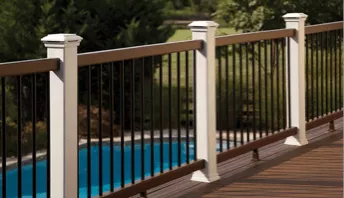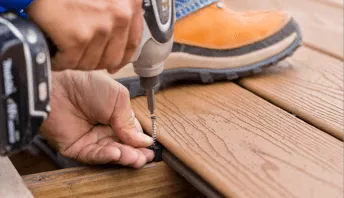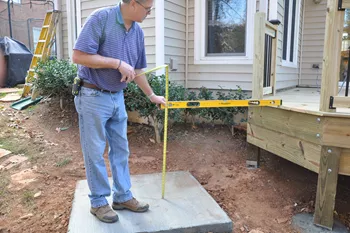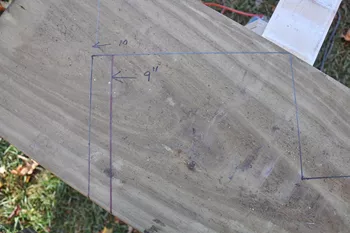How to Lay Out Deck Stair Stringers
After talking to many deck builders over the years, we have found that stair construction is considered the most difficult part of building a deck. In order to find the right stair stringer layout for your stairs, you first need to measure the exact height of the deck from the top of the decking to the location where the stairs are going to land on the ground. You can input this number into our Stairs Calculator on Decks.com. The calculator will provide you with the number of stairs, riser height and tread depth to cut your stringers. You will need to remove the thickness of the riser board from the top stair and remove the thickness of the tread board from the bottom stair. You can now draw the notches for the stairs onto your 2x12 stair stringers. The difference between the stair rises and tread depths cannot vary by more than 3/8" from the largest to the smallest.
Deck Stair Stringers Spacing

The load supporting requirements for stair treads are more severe than for the rest of the deck because the force exerted by a person walking downstairs is a more intense blow to the surface than a standard stride across a level surface. Because of this, you should never space your stair stringers more than 16” on center. This means you will need to install a minimum of four stringers on any stairway wider than 36”. Always check the maximum span for your decking material as it applies to stair treads.
Some composite materials and lower-grade 5/4 wood decking may require you to reduce the stringer spacing to 10” on center. Always read the composite decking installation instructions for stair treads before building your stairs. It is best policy to overbuild your stairs because of the increased wear and tear they often receive. Pay particular attention to the stringer placement if you are attaching stairs around a corner, as in the case of a cascading staircase.
Determine the total rise for your stairs using a level and a tape measure. Measure the distance from the top of the deck surface to the top of the stair landing. Input the total rise number into the Decks.com Stairs Calculator to determine the number of stairs, each stair rise and run for laying out your stair stringers. The above example shows outside drop-mounted stairs.
Using the information from the Decks.com Stairs Calculator, mark your rise and run on the framing square. The above image shows drawing the top step run at 10" and the rise at 6-3/8".
Learn more about building deck stairs with Decks.com’s detailed instructions.
How to Build Box Steps for Your Deck
Learn how to build a set of box platforms to act as stairs for a low deck. You don't need to cut stair stringers.
Support Long Stringers
Long stair stringers may need extra support from installing a brace at mid-span.
Building Cascading or Wrap Around Stairs
Learn how to build a set of cascading or flared stairs around an angled corner of a deck.
Glass Deck Railing Ideas and DIY Installation Tips
All glass panels used for deck railings must be safety-tempered and shatter-resistant. Learn how to install glass railing panels and get ideas for your deck.
Best Aluminum Deck Railings: Reviews & Benefits
Aluminum deck railings are a great low maintenance option for any home. Compare different materials and find the best aluminum deck railing system for you.
Deck Railing Height Requirements
Understanding deck railing height is important for meeting code requirements. Learn how high you should build your deck railing.
More Helpful Resources
Explore Articles by Topic

Footings
Information related to installing frost footings for decks

Framing
Learn structural framing methods

Decking
Learn about wood and composite decking materials

Stairs
An in-depth look at the complex issue of how to build stairs

Railings
How to install guardrails and handrails to meet IRC code

Features
An overview on water drainage, benches, planters and lights

Design
The basics of deck design

Planning
Learn about permits and working with contractors

Porches & Patios
Build a covered deck to enjoy all seasons

Ledger
Proper attachment techniques

Care
Maintain your deck to maintain your investment

Materials
An overview on water drainage, benches, planters and lights
Closed Stair Risers
Learn about the benefits of installing riser boards on your deck stairs.
Cutting Stair Stringers
The stair stringers are essentially the backbone of your staircase. Learn how to properly measure, cut, and build deck stair stringers.
Reddit Railing Questions Answered
Deck railing is an essential component of any deck, providing both safety and style. However, with so many materials, designs, and installation factors to consider, questions often arise.
How to Build & Install an Outdoor Deck Gate
In this easy-to-follow guide, we explain the process of building a deck gate and installing it on your deck.
Cocktail Railing Considerations & Ideas
A cocktail rail is the ideal enhancement for a deck railing. Explore what to consider when introducing a drink rail to your deck.
Explore Articles by Topic

Footings
Information related to installing frost footings for decks

Framing
Learn structural framing methods

Decking
Learn about wood and composite decking materials

Stairs
An in-depth look at the complex issue of how to build stairs

Railings
How to install guardrails and handrails to meet IRC code

Features
An overview on water drainage, benches, planters and lights

Design
The basics of deck design

Planning
Learn about permits and working with contractors

Porches & Patios
Build a covered deck to enjoy all seasons

Ledger
Proper attachment techniques

Care
Maintain your deck to maintain your investment

Materials
An overview on water drainage, benches, planters and lights

























